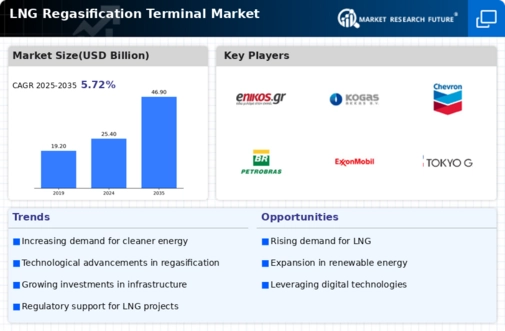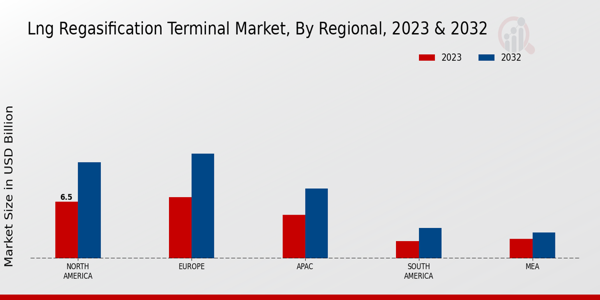Market Growth Projections
The Global LNG Regasification Terminal Market Industry is poised for substantial growth, with projections indicating a market value of 25.4 USD Billion in 2024 and an anticipated increase to 46.9 USD Billion by 2035. This growth trajectory suggests a compound annual growth rate (CAGR) of 5.72% from 2025 to 2035. The expansion of regasification terminals is expected to be driven by rising global energy demands, technological advancements, and supportive government policies. As countries continue to invest in LNG infrastructure to enhance energy security and meet environmental targets, the market is likely to witness significant developments in the coming years.
Increasing Demand for Natural Gas
The Global LNG Regasification Terminal Market Industry is experiencing heightened demand for natural gas as a cleaner alternative to coal and oil. Governments worldwide are implementing policies aimed at reducing carbon emissions, thereby promoting the use of liquefied natural gas. For instance, in 2024, the market is projected to reach 25.4 USD Billion, driven by the transition towards sustainable energy sources. This shift is particularly evident in regions such as Asia-Pacific, where countries like China and India are ramping up their LNG imports to meet growing energy needs. The increasing reliance on natural gas is likely to bolster the development of regasification terminals.
Infrastructure Development Initiatives
Infrastructure development initiatives play a crucial role in the expansion of the Global LNG Regasification Terminal Market Industry. Governments and private entities are investing significantly in building new terminals and upgrading existing facilities to accommodate rising LNG demand. For example, several countries in Europe are enhancing their regasification capacities to diversify energy sources and enhance energy security. This trend is expected to continue, with the market projected to grow at a CAGR of 5.72% from 2025 to 2035. Such investments not only facilitate the import of LNG but also contribute to job creation and economic growth in the regions where these terminals are established.
Geopolitical Factors and Energy Security
Geopolitical factors are increasingly influencing the Global LNG Regasification Terminal Market Industry as countries seek to secure their energy supplies. The volatility of oil prices and regional conflicts have prompted nations to diversify their energy sources, with LNG emerging as a preferred option. For instance, European countries are actively seeking to reduce their dependence on Russian gas by investing in LNG infrastructure. This strategic shift is expected to drive the market's growth, with projections indicating a market value of 46.9 USD Billion by 2035. The focus on energy security is likely to lead to increased investments in regasification terminals across various regions.
Technological Advancements in Regasification
Technological advancements in regasification processes are transforming the Global LNG Regasification Terminal Market Industry. Innovations such as floating storage and regasification units (FSRUs) are gaining traction due to their flexibility and reduced capital costs compared to traditional land-based terminals. These advancements enable quicker deployment and can be particularly beneficial for emerging markets seeking to enhance their energy infrastructure. As a result, the market is likely to see an increase in the number of FSRUs, further driving growth. The integration of advanced technologies not only improves efficiency but also enhances safety and environmental performance in LNG operations.
Environmental Regulations and Sustainability Goals
The Global LNG Regasification Terminal Market Industry is significantly influenced by stringent environmental regulations and sustainability goals. Governments are increasingly mandating lower emissions and promoting cleaner energy sources, which enhances the attractiveness of LNG as a transitional fuel. This regulatory environment encourages investments in LNG infrastructure, as companies seek to comply with environmental standards while meeting energy demands. The emphasis on sustainability is likely to drive innovation in regasification technologies, further supporting market growth. As countries commit to net-zero targets, the role of LNG in the energy transition becomes more pronounced, potentially leading to a more robust market landscape.






















